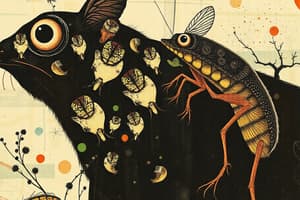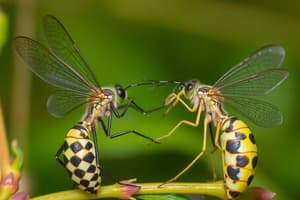Podcast
Questions and Answers
What is coevolution?
What is coevolution?
The process by which two or more species reciprocally influence each other’s evolution through interactions.
What is mutualism?
What is mutualism?
A type of symbiosis where both species benefit from the interaction.
What is commensalism?
What is commensalism?
A symbiotic relationship where one species benefits while the other is neither helped nor harmed.
What is parasitism?
What is parasitism?
What defines obligate mutualisms?
What defines obligate mutualisms?
What distinguishes facultative mutualisms?
What distinguishes facultative mutualisms?
What is altruism in terms of animal behavior?
What is altruism in terms of animal behavior?
What is eusociality?
What is eusociality?
What is kin selection?
What is kin selection?
How can mutualisms enhance fitness?
How can mutualisms enhance fitness?
What was the effect of the myxoma virus on rabbit populations in Australia?
What was the effect of the myxoma virus on rabbit populations in Australia?
Flashcards are hidden until you start studying
Study Notes
Symbioses
- Coevolution: Two or more species influencing each other's evolution through interactions like predation, competition, or mutualism
- Mutualism: Both species benefit from the interaction, e.g., bees pollinating flowers while collecting nectar
- Commensalism: One species benefits, the other is neither helped nor harmed, e.g., birds nesting in trees
- Parasitism: One species (parasite) benefits at the expense of the other (host), causing harm but not immediate death, e.g., ticks feeding on mammals
- Parasitoidism: A parasitoid (often an insect) lays eggs on/in a host, and developing larvae kill the host, e.g., certain wasps and caterpillars
- Phoresy: One organism uses another for transportation, e.g., remoras on sharks
- Obligate Mutualisms: Both species are entirely dependent on each other for survival
- Facultative Mutualisms: Both species benefit but are not dependent on each other for survival
Sociality
- Cooperation: Individuals work together for a common benefit, e.g., hunting in packs, sharing resources
- Altruism: An individual sacrifices its own fitness to help others, often relatives, e.g., animals warning their group of predators
- Eusociality: Complex social organization with cooperative brood care, overlapping generations, and division of labor, e.g., ants and bees
- Kin selection: Natural selection favoring altruistic behavior toward relatives, increasing the indirect fitness of the altruist by helping relatives pass on shared genes
Mutualism
- Fitness: An organism's ability to survive, reproduce, and pass on its genes
- Mutualisms enhance fitness for both species by providing benefits, such as food, protection, or other resources
- Case study: A bee pollinating a flower benefits by receiving nectar (increasing its fitness), while the plant increases its fitness through successful reproduction
- Mutualisms are a result of coevolution, in which both species evolve in response to the other and optimize their fitness
- Plants and animals use various structures and behaviors to obtain food, shelter, and protection through mutualistic interactions
Myxomatosis & Invasive Rabbits
- In 1859, two dozen rabbits were released in Australia.
- Populations exploded due to abundant food, lack of natural predators, and competitors.
- Myxoma virus, related to smallpox and carried by mosquitos, was introduced as a biological control.
- The virus, initially highly deadly, caused a decline in rabbit populations.
- Coevolution: Over time, virus and rabbits coevolved, with the virus becoming less deadly and rabbits developing some resistance.
Studying That Suits You
Use AI to generate personalized quizzes and flashcards to suit your learning preferences.




